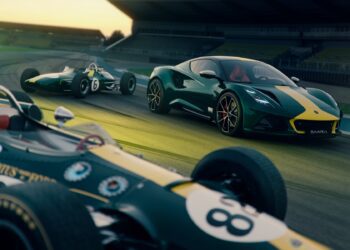 Electric vehicles
Electric vehicles
With the automotive industry swiftly shifting gears towards electrification, Lotus has made headlines with its innovative approach to integrating electric and hybrid technology into its performance cars. As enthusiasts and industry watchers eagerly anticipate updates, Lotus News: Performance & Electric Future – Autoblog remains a hot topic, promising a blend of speed, efficiency, and environmental stewardship.
Lotus’s journey is marked by milestones and challenges, as the brand navigates through the complexities of electric vehicle (EV) production while honoring its heritage of creating lightweight, high-performance machines. This article delves into the latest developments and future projects shaping the destiny of this iconic marque.
What delays are affecting the launch of the Lotus Type 135 electric sports car?
The anticipation surrounding the Lotus Type 135 electric sports car has been met with a series of delays, raising questions about the factors impeding its arrival. Lotus is confronting the typical hurdles that come with launching a groundbreaking EV, from perfecting cutting-edge technology to ensuring production readiness.
Other factors include supply chain issues and regulatory challenges. These are common among automakers in today’s market, where the demand for EV components often outstrips supply. Lotus is committed to overcoming these obstacles to deliver a vehicle that meets its high-performance standards while embracing an electric future.
Despite the delays, Lotus assures fans that the Type 135 will be worth the wait, boasting a design that harmonizes aerodynamic efficiency with the brand’s signature style. The company is focused on quality, innovation, and sustainability as it progresses towards launch.
How is Lotus adapting to the transition towards electric vehicles?
Lotus’ adaptation to the EV market involves a multifaceted strategy. The company is fully embracing electrification, with initiatives aimed at developing advanced EV powertrains and exploring hybrid solutions.

Enhancing infrastructure is another key focus, as Lotus invests in manufacturing facilities equipped to handle the unique demands of electric vehicle production. This includes upskilling its workforce and forming strategic partnerships with leading technology providers.
Furthermore, Lotus is tapping into its racing heritage to inform the development of its EVs. The brand’s expertise in lightweight construction and dynamic handling is being leveraged to ensure that its electric cars offer the exhilarating performance expected from a Lotus.
What are the features of Lotus’s plug-in hybrid models?
- Innovative “Super Hybrid” technology that combines turbocharged engines with electric batteries.
- Impressive target range of approximately 680 miles on a single charge and fill-up.
- Swift charging capabilities that cater to the needs of performance enthusiasts and everyday drivers alike.
- Advanced regenerative braking systems that harvest energy to recharge the battery while on the move.
Why are hybrids considered a practical solution for Lotus?
Hybrids serve as a pragmatic bridge between conventional combustion engines and the future of electric mobility. For Lotus, hybrid models offer an opportunity to transition gracefully into the EV era without abruptly disrupting its existing lineup.
Hybrids enable Lotus to maintain the thrilling driving experience it’s known for, while also satisfying increasing consumer demand for greener vehicles. The use of hybrid technology allows for significant reductions in emissions and improved fuel economy.
Moreover, the development of hybrid models equips Lotus with valuable insights into electrification, which can be applied to future all-electric models. This step-by-step approach ensures Lotus remains competitive and relevant in a rapidly evolving market.
What engines power the Lotus Emira and how are they electrified?
The Lotus Emira is ushered into the electrified era with two distinct powertrains, both of which are set for electrification. The first, a turbocharged 2.0L engine sourced from Mercedes’ AMG division, and the second, a supercharged 3.5L V6 from Toyota, are engineered to accommodate hybrid technology.

These powerplants will incorporate electric motors and battery systems, enhancing performance while reducing the environmental impact. The transition to hybrid variants is a strategic move by Lotus, as it allows the brand to offer a range of powertrains that cater to varying customer preferences.
With a dedication to electrification, Lotus ensures that the Emira’s legacy will not only be one of performance excellence but also of progressive environmental consciousness and technological innovation.
What is the current status of the Lotus Type 134 electric SUV project?
The Lotus Type 134 project, an ambitious endeavor to introduce an electric SUV to the Lotus lineup, has been postponed. This decision reflects the challenges and shifts in EV adoption, as well as market trends that demand strategic flexibility.
Despite the delay, Lotus remains dedicated to the project, understanding the importance of diversifying its portfolio to include vehicles that appeal to a broader audience. The Type 134 is poised to blend Lotus’s performance pedigree with the practicality and popularity of SUVs.
The company is closely monitoring the market to determine the optimal time to introduce the Type 134. Lotus’s commitment to pioneering in the electric mobility space is unwavering, and the future of the Type 134 electric SUV is an integral part of that vision.
To offer a glimpse into the world of Lotus’s electrified future, here’s a closer look at their innovation in action:

Questions related to Lotus’s performance and electric future
What is the current status of Lotus’s electric vehicle projects?
Lotus is actively developing its electric vehicle lineup, with key projects such as the Type 135 electric sports car and the Type 134 electric SUV. While facing delays, these projects exemplify the brand’s strategic pivot towards electrification.
The Type 135 is particularly significant, as it represents a bold step into all-electric territory, signaling Lotus’s commitment to a zero-emission future. Though timelines have shifted, Lotus’s resolve to bring these electric dreams to fruition remains steadfast.
How is the Lotus Emira adapting to electric technology?
The Lotus Emira, the brand’s latest combustion engine sports car, is designed with future electrification in mind. The incorporation of hybrid technology into its powertrains paves the way for a seamless transition to electric propulsion.
This strategy allows Lotus to maintain the Emira’s core essence while embracing the benefits of electric technology, ensuring a sustainable and performance-oriented future for the model.
What challenges is Lotus facing with its Type 135 launch?
Lotus’s Type 135 launch presents several challenges, ranging from the intricate process of EV development to market readiness and supply chain complexities. Each challenge is being methodically addressed to ensure the final product lives up to the brand’s storied reputation.

Ensuring the Type 135 adheres to Lotus’s ethos of lightweight, agile, and driver-focused vehicles while incorporating electric technology is a delicate balancing act that demands precision and innovation.
What are the specifications of Lotus’s hybrid engines?
Lotus’s hybrid engines are set to deliver performance and efficiency in equal measure. Specifications include advanced battery technology, electric motors that augment the internal combustion engines, and regenerative braking systems.
The hybrid powertrains are engineered to offer a substantial electric-only range, fast charging, and a total combined range that competes with traditional fuel-powered engines.
How does the “Super Hybrid” system work?
The “Super Hybrid” system is Lotus’s cutting-edge answer to high-performance hybrid technology. It works by integrating a traditional internal combustion engine with a powerful electric motor and a rapidly charging battery pack.
This synergistic combination allows for quick bursts of electrically assisted power, extended range capabilities, and an engaging driving experience that is quintessentially Lotus.
Through innovation and adaptability, Lotus is steering towards a future where performance and sustainability coexist. The brand’s journey into the realm of electric and hybrid vehicles signifies an exciting era for Lotus enthusiasts and the automotive industry at large.


Comments
Avery Callahan
Posted on 13 September 2024I’m really impressed by Lotus’s approach to integrating electric and hybrid technology while staying true to their performance roots. It’s exciting to see a brand like Lotus embrace electrification without compromising on the thrilling driving experience they’re known for. The challenges they’re facing, like with the Type 135, just show their commitment to ensuring quality and innovation. Can’t wait to see how these projects unfold, especially the “Super Hybrid” tech and the electric SUV. It feels like a new era for Lotus that’s both sustainable and exhilarating!